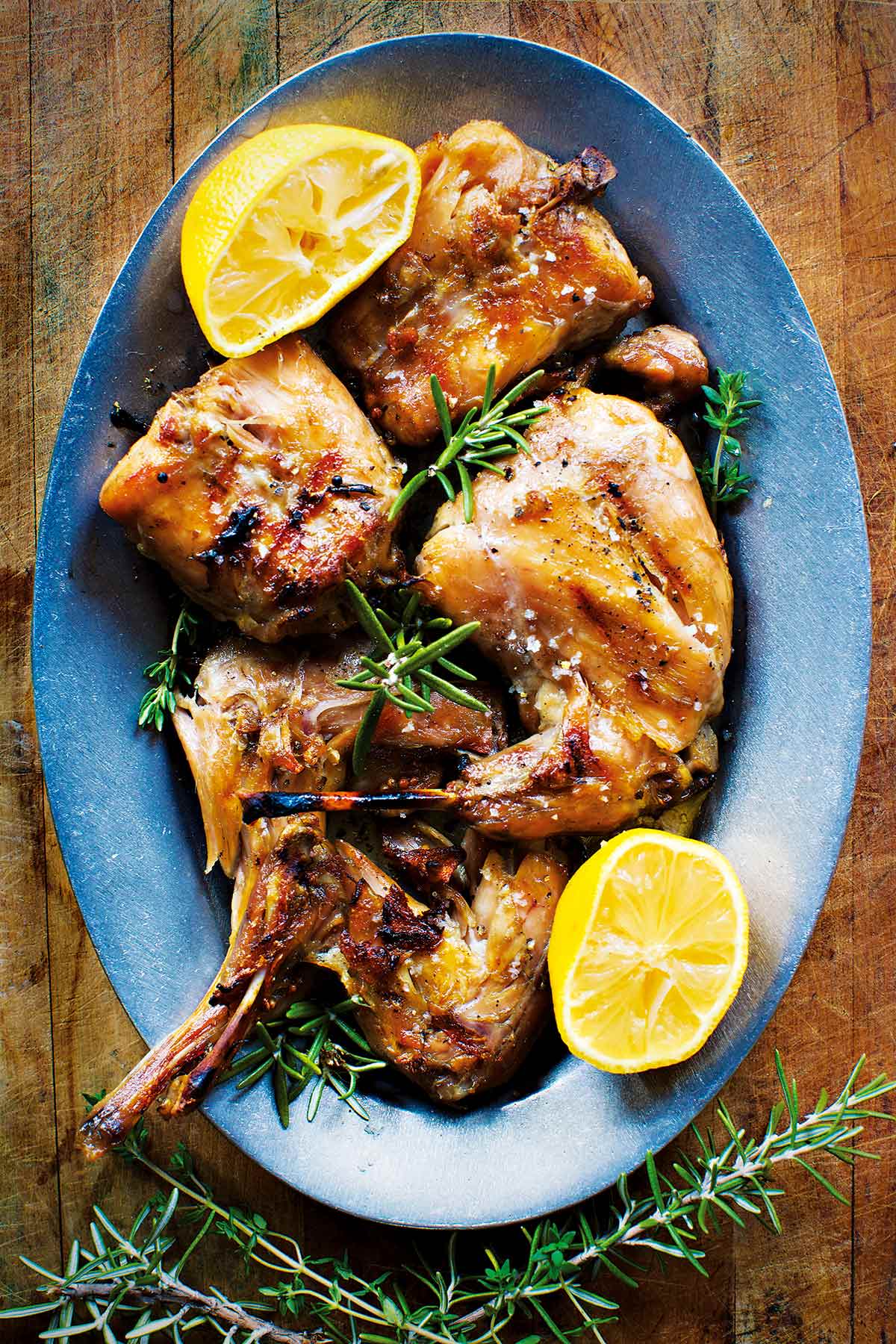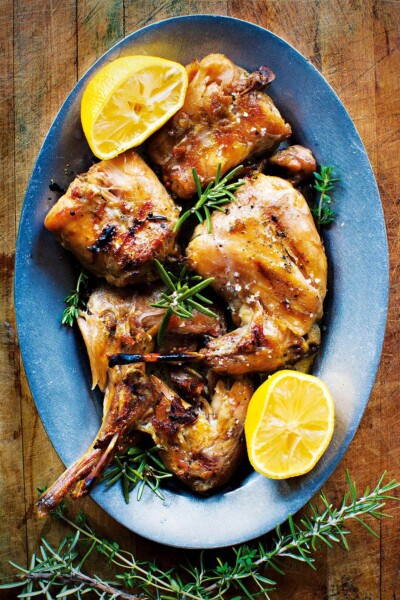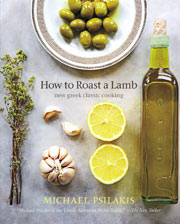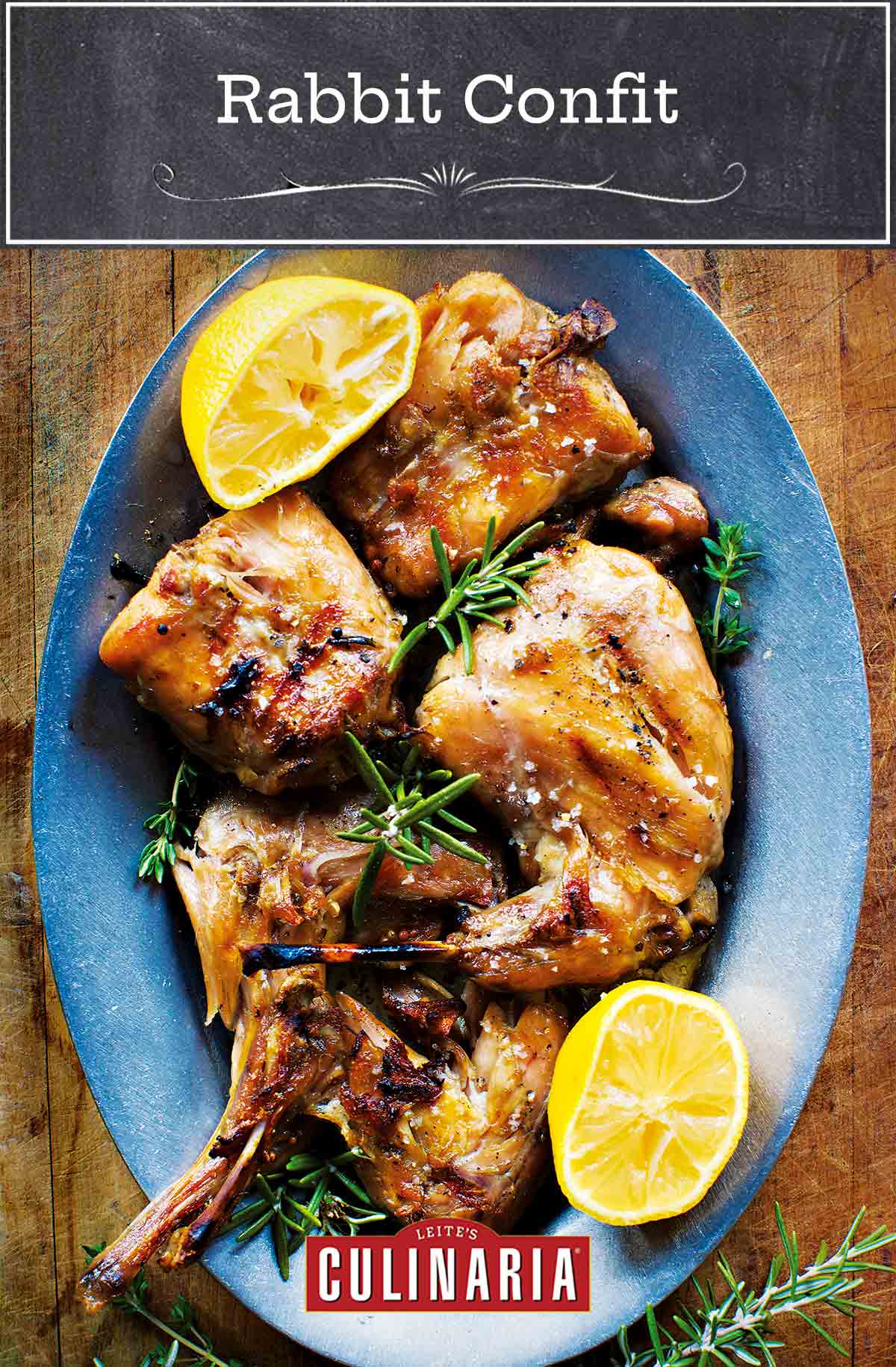
Want to Save This?
The muscle formation in the legs of most animals makes for tough, stringy meat. Confit involves cooking slowly, which allows these formations to break down and yield a luscious result. The added dimension of grilling or searing it in a skillet provides a brilliant smoky char that takes this dish to new levels.–Michael Psilakis
LC OPTIONS GALORE NOTE
The talented, gracious, and pragmatic author of this recipe, Michael Psilakis, was generous enough to share a few more ways to experience rabbit confit…
– Lightly cure the meat before making it into a confit: mix 3 tablespoons kosher salt with 1 tablespoon sugar. Rub the mixture all over the pieces and place on a rack in your refrigerator overnight, uncovered. Rinse well and pat dry thoroughly with paper towels before you begin the confit.
– Leftover rabbit confit makes the very best deep-fried rabbit you’ll ever have: Just smear the pieces with Dijon mustard and then bread them as you would for deep-frying, using milk, flour, beaten egg, bread crumbs or panko. Fry until golden brown.
– You may strain the rabbit-infused confit cooking oil and use it to make a quick vinaigrette or to roast some mushrooms to serve alongside. The oil will add another dimension of flavor.

Rabbit Confit
Ingredients
- 1 whole rabbit, skinned and cut into 8 pieces
- 1 shallot, peeled
- 10 cloves garlic, peeled
- 3 fresh bay leaves or 6 dried
- 8 cloves
- 15 to 20 whole black peppercorns
- 8 star anise pods
- 16 juniper berries
- 6 cardamom pods
- 10 sprigs thyme
- 4 sprigs rosemary
- 1 teaspoon mustard seeds, (yellow or brown)
- Kosher salt and cracked black pepper
- About 3 to 6 cups or so oil, (I usually use a blend of 90 percent canola and 10 percent extra-virgin olive, although you can change that to 50 percent canola and 50 percent olive oil.)
- Lemon wedges, for squeezing
Instructions
- Preheat the oven to 300°F (148° C). Rinse the rabbit under cold running water and pat dry with paper towels.
- In a heavy-lidded 4-quart or larger pot or a large Dutch oven, combine the rabbit with the shallot, garlic cloves, bay leaves, cloves, peppercorns, star anise pods, juniper berries, cardamom pods, thyme, rosemary, mustard seeds, and 1 tablespoon of kosher salt. Add enough oil to cover the meat by about half an inch. Place a piece of parchment paper cut to fit your pot on the surface of the oil. Cover the pot with its lid and slide it into the oven.
- Check the contents of the pot occasionally—the oil should never come to a full simmer. You may need to reduce the heat. Cook until the meat is tender but not falling apart, about 3 hours. Remove the pot from the oven. (To make the confit in advance, you can cool the rabbit to room temperature and refrigerate overnight or up to 3 days. You must slowly heat the pieces in confit oil in a warm oven before grilling or searing, otherwise, the center will be cold.)
- Preheat a charcoal or gas grill or ridged cast-iron grill pan until hot but not smoking. Lift the pieces out of the confit oil and season with pepper. Reserve the oil until serving time. Lightly sear the meat just long enough to warm it and imbue it with a smoky char flavor (remember, the rabbit is already cooked, you just want to warm it through).
- Drizzle the meat with a little of the confit oil and squeeze a wedge of lemon over it.
Notes
What can I substitute for juniper berries?
This rabbit confit recipe has loads of herbs and spices in it, so if you’re missing one you might be okay without it. Having said that, juniper berries are an interesting addition. They’re what gives gin its flavor and its name (gin being both the Dutch and French word for juniper), and the distinct taste is something rather exceptional. However, if you can’t get any or you already know that you don’t care for the flavor (especially if you don’t care for the taste of gin), you might want to consider an alternative. Tasting of pine, with undercurrents of peppery fruit, rosemary will stand in quite well. Since this recipe already uses rosemary, you might just want to add a bit more. In a pinch, caraway seed is also a good substitute. Generally used in sausages when juniper berries aren’t available, you should find it works well here, too.
Nutrition
Nutrition information is automatically calculated, so should only be used as an approximation.
Recipe Testers’ Reviews
This recipe wasn’t cheap to make, but it was worth every penny. It was a nice change from all of the other braised rabbit recipes out there. It was also pretty easy to pull off—just throw everything in a pot, pop it in the oven, and let it be. I neglected to season the meat with salt before grilling, but that was a good thing, as the meat was plenty salty without it. I also reduced the heat about halfway through simmering.
Try to grill this over a wood fire if possible. Getting a bit of a smoky flavor really adds another dimension to this meat. At the very least, use some wood chips on your grill. It’s hard to describe how good the finished meat is, but I’ll try: extremely tender, flavorful, with a hint of smoke. And, you can taste all of those spices that went into the oil, but none are overpowering. It’s rustic and sophisticated all at once. A really amazing meal.
I love duck confit, so I just had to try this rabbit confit. Both the lightly cured and non-cured versions offer a lot of flavour, and they’re worth the time invested to try them out. The cured confit has a rich, salty-savoury flavour, whereas the non-cured confit is somewhat more delicate.
When I prepared this recipe, it seemed the star anise was a bit stronger than the other ingredients so, in the future, I may use about one-half to two-thirds of the amount called for. (Lightly crushing the juniper and cardamom should open up their flavours more, too.) The mustard seeds weren’t perceptible in either version, and I‘m not sure how much more to add, or if it’s even necessary. Luckily, it’s easy to adjust any of the ingredients, allowing you to tailor the confit to your own taste.
The meat came out very tender and extremely tasty. I first cooked it in a deep, lidded terra-cotta dish, then browned it over the stove in a cast-iron skillet. For the leftover pan juices, I removed the bay leaves and star anise then removed most of the fat and blended it into a sauce. We ended up with a beautifully tasty gravy that we ladled over the rabbit and mashed potatoes.
This dish makes any home cook look like a professional chef. Rabbit is one of those meats that scares away most people, and the word “confit” usually is a process associated with duck legs. For those reasons (and because I’ve eaten incredible rabbit dishes in Europe), I wanted to disprove the myths and show that with a bunch of beautifully fragrant spices and several hours, I could put together a world-class dish.
My poaching liquid consisted of a 50/50 ratio of olive oil and canola oil, but note that the oil came to a simmer in a 300ºF oven, so it’s necessary to keep the temperature around 250ºF in this case. After poaching the rabbit, make sure to soak up the extra oil and then grill (I left out the extra salting step). The crispy, smoky crust contrasts perfectly with the succulent, melt-in-your-mouth meat. The burst of lemon is downright essential to liven up this heavy dish. I’ve already used the leftover infused oil to braise greens and to create mayonnaise. Also, consider spreading the roasted garlic on toast. This is a true winner of a recipe!














This recipe is a honest a true gem!! I tried it last night with a wild rabbit I had hunted. I had previously had the rabbit meat in a brine for 10 hours when i found this recipe! I was originally going to just braise it but then i thought, “this has GOT to be better than braising it” I followed the recipe but only added half of the herbs and spices and no salt. (I did this because my brine already had plenty of salt)
Oh my goodness!! This IS the best rabbit I’ve had hands down. My wife and I ate the every last bit. thank you so much for posting this. I got two rabbits on my hunt so on the next one I am going to follow this recipe to a T to see if i can save myself from having to brine it every time i want to make this. (that said, Brine is definitely the way to go, every bit was so tasty!)
Highly recommend this recipe!
Ike, that’s terrific! I’m so grateful that you let us know how much you and your wife like this. Our testers enjoyed it immensely, so we were confident it was a truly reliable recipe, but we always like to hear about others’ experiences. My husband loves rabbit so I’m going to remind him of this recipe and share your recommendation with him. Thank you!
Didn’t know that there was a rabbit confit recipe in this world… My grandmother used to cook rabbit in “civet” with rabbit blood but nowadays, if you don’t leave in a rural area, you can’t find rabbit and its blood. It’s a pity but rabbit confit looks as an unexpected rabbit recipe and that’s fun!
sylvie, if you make it, please let me know what you think.
I’ve noticed a lot of people comment on various culinary sites on the expense of rabbit, and it makes me wonder, why not raise your own? I keep one buck (male) and three females and it keeps my family in meat quite tidily. Rabbits are quiet, easy to care for, and require little space, although we keep ours in large individual hutches. And while slaughter is not an enjoyable task, it is quicker and cleaner to dispatch and dress out a rabbit for the table than a chicken. Add in the benefit of knowing with certainty that our animals had safe, clean environments, no hormones or animal products in their feed, and a humane end, and it really sold us on raising our own. Not saying it’s for everyone, but certainly consider it or look for small farmers in your area. Here in IN local growers only charge about $2 lb for a rabbit fryer.
You raise some really interesting points, rabbit raiser. Many thanks. And $2 a pound? Holy cow. Er, holy bunny. That’s a terrific price.